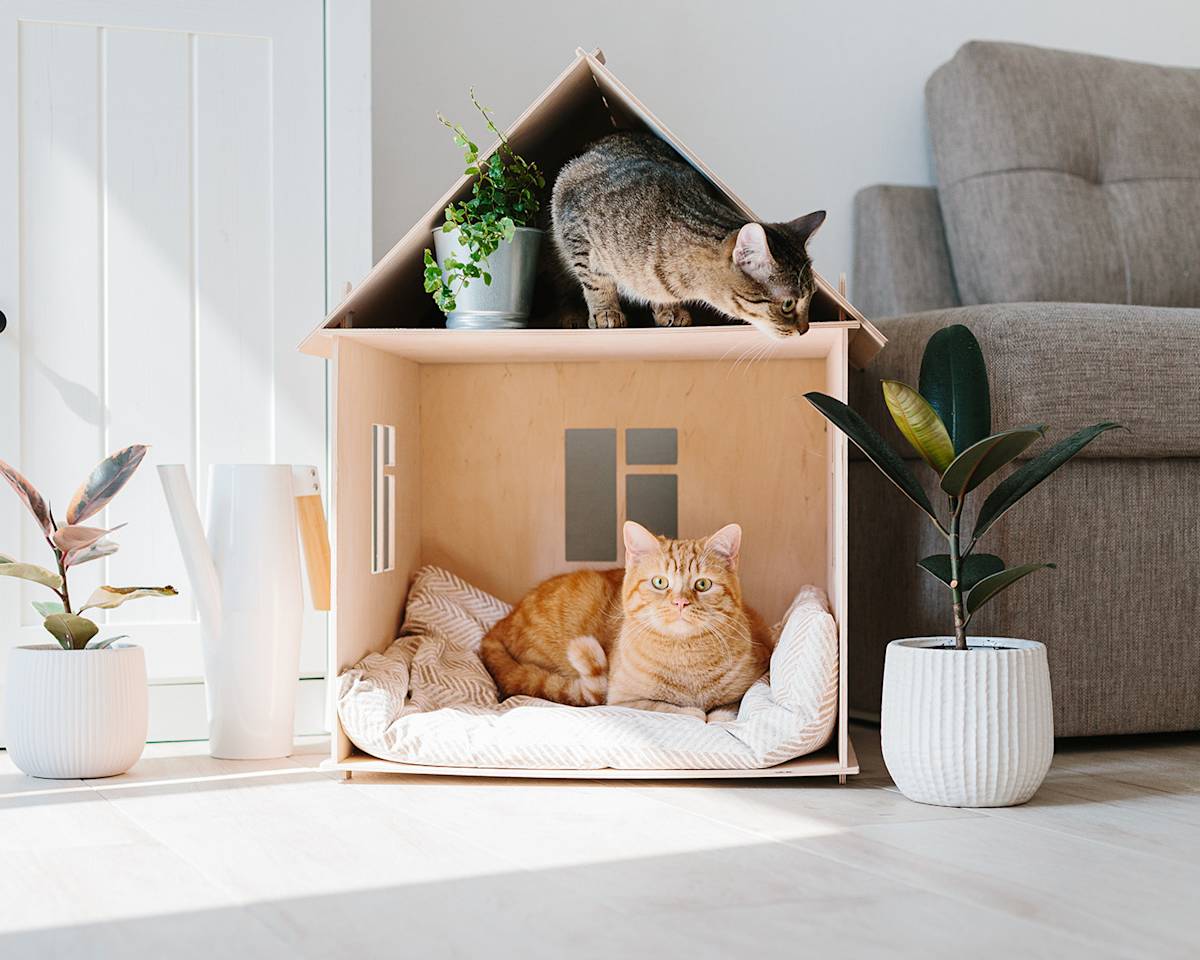7 Ways to Manage a Multi-Cat Household
The dream is not without it’s challenges

Share Article
Living in a multi-cat household can be incredibly rewarding – more purrs, more play and more feline affection. But it’s not without its challenges. From turf wars over litter boxes to mealtime squabbles and personality clashes, managing multiple cats can test even the most devoted pet parent.
This guide breaks down the seven most common issues faced in a multi-cat household and offers practical solutions to help restore harmony.
Understanding multi-cat dynamics
Cats are not pack animals by nature. While some cats can form strong social bonds, others prefer their space. In a multi-cat household, understanding cat social behaviour is key to maintaining peace.
Unlike dogs, cats form loose social structuresopens in new tab called colonies, often centred around shared resources. Conflict typically arises when resources – litter boxes, food, space – are scarce or poorly distributed.
In the UK, it’s increasingly common to have more than one cat at home. According to the PDSA’s 2024 PAW Reportopens in new tab, 42 percent of cats now share their homes with other cats. And interestingly, only 25 percent of those cats enjoy living alongside each other; and 17 percent who live with one or more other cats don’t always get along – meaning 1.8 million cats are potentially stressed by their cat companion.
Litter box wars and territorial issues
Litter box issues are one of the most common and frustrating problems in a multi-cat household. When a cat starts urinating outside the tray, it’s often misread as a house-training failure, when in fact it’s usually a response to stress or territorial tension.
Urinating outside the tray, frequent spraying or guarding behaviour around the litter box often signals a territorial dispute. Some cats may even block access to the litter tray, intimidating more submissive cats and creating anxiety around toileting.
The golden rule: one litter box per cat, plus oneopens in new tab. So if you have three cats (dreamy), aim for four trays. This helps reduce competition and ensures that every cat has access to a clean and safe space.
Placement is crucial, too. Avoid clustering trays together, as this can make them feel like one shared resource. Instead, place them in different, low-traffic areas of the home. Ideally, each box should offer a level of privacy, easy access, and an escape route so that no cat feels trapped.
The type of litter also matters. Unscented, clumping litter usually comes out on top for catsopens in new tab, and consistency is key. Avoid switching litter types too often, as cats can be sensitive to changes in texture and smell.
Cleaning protocols should be rigorous. Scoop at least once a day, and do a deep clean with mild soap and warm water weekly. Avoid bleach or strong-smelling cleaning products, which can deter cats from using the tray.
In some cases, cats may also prefer different types of trays. Offering a mix of open and covered trays can give your cats a choice and may reduce territorial disputes.
Food competition and mealtime stress
Feeding time in a multi-cat household can quickly turn into a battleground. Food aggression, gulping, guarding or even hiding during meals are all signs that the current setup is causing stress.
Cats are solitary hunters by nature. Unlike dogs, they don’t naturally eat in groups, so sharing a food area can cause serious anxiety.opens in new tab In households with multiple cats, competition over food can lead to overeating, under-eating or even fights.
The best approach is to create separate feeding stations for each cat. Place bowls in different rooms or use physical barriers like baby gates or furniture to give each cat a peaceful space to eat. If separate rooms aren’t possible, feed cats at different heights or use microchip-activated feeders to ensure each one eats their own portion.
Timed feeding rather than free feeding helps reduce anxiety and builds routine. It also allows you to monitor how much each cat is eating, which is especially important for managing weight and overall health.
Cats with special dietary needs – such as kidney support diets or kitten food – should be fed separately in a secure room where other cats can’t access their food. It can be helpful to create a feeding chart or schedule, especially in larger households.
For nervous or easily distracted eaters, enrichment tools such as puzzle feeders, lick mats or treat-dispensing toys can help slow things down and provide mental stimulation.
Be patient when making changes, and try to associate mealtimes with calm, positive experiences. Never punish a cat for food-related behaviour, as it can increase stress.
Aggression and fighting
Aggression between cats can take many formsopens in new tab – from subtle signs like prolonged staring or body-blocking to more obvious behaviours like hissing, swatting or chasing.
Understanding the type of aggression is essential:
Territorial: one cat believes an area belongs to them exclusively.
Redirected: a cat lashes out at another due to frustration from an external source.
Fear-based: a nervous cat reacts defensively.
Status-related: a more confident cat tries to assert dominance.
Before aggression escalates into a full-blown fight, look out for warning signs such as tail flicking, ears pinned back, sudden stillness or avoidance behaviour. Cats often use subtle body language to communicate long before a conflict becomes physical.
Never attempt to physically break up a cat fight. Instead, make a loud noise (like clapping) or use a cushion or blanket to separate them visually. Provide each cat with space to calm down in a separate area.
If aggression is ongoing, it may be necessary to temporarily separate the cats and reintroduce them slowly. Use scent swapping (rubbing a cloth on one cat and placing it near the other), controlled visual exposure (like a baby gate or screen door), and gradual supervised interactions.
Pheromone products such as Feliway can help reduce tension, and in some cases, a vet may recommend calming supplements or medications.
When fights become frequent or severe, consult a feline behaviourist to prevent long-term issues.
Vertical territory and space management
In a multi-cat household, physical space can quickly become a source of tension. That’s where vertical territory comes in.
Cats love to climb, perch and observe their surroundings from above. Providing vertical options not only gives them exercise but also allows them to claim their own ‘zone’ without needing to compete on the ground level.
Use cat trees, wall-mounted shelves, sturdy bookcases or even purpose-built climbing furniture to create ’cat highways‘ – interconnected routes that allow cats to move around without getting in each other’s way. The goal is to minimise confrontation by allowing cats to pass each other or retreat if needed.
Each room should ideally have multiple levels of vertical space. Place perches near windows for added enrichment and to give cats something to focus on beyond their housemates.
Make sure that high spaces are stable and can accommodate the weight of your cats safely. You can also add scratching posts to give cats an outlet for marking territory without damaging furniture.
This kind of enrichment isn’t just about conflict prevention – it also helps with exercise, mental stimulation and overall well-being.
Introducing new cats to the household
Introducing a new cat into an established multi-cat household can be tricky – but with patience, it can be done smoothlyopens in new tab. Cats are naturally territorial and rarely take kindly to strangers of any species just showing up in their space.
A step-by-step approach is key. Start by keeping the newcomer in a separate room, complete with their own litter tray, food and bedding. This helps them feel secure while also preventing direct conflict with resident cats.
Next, swap items like blankets or toys between rooms to allow both cats to get used to each other’s scent. You can also rub a soft cloth on one cat and place it near the other’s sleeping area. This scent-swapping process should last at least a few days.
Once both cats seem calm and curious, you can allow limited visual contact – such as cracking a door open or using a baby gate. Watch their body language: relaxed tails and curious sniffing are good signs. Hissing or growling means you may need to slow things down.
Supervised face-to-face meetings come last. Keep them short and positive. Use treats or play to build positive associations. Gradually extend the time they spend together, always ending on a good note – ie, finish up the session before anything negative arises between them.
Common mistakes include rushing the process, neglecting the emotional needs of the original cats or failing to provide enough resources. It’s also important to ensure the new cat doesn’t feel overwhelmed (remember your first weeks at school?)
Expect the full integration to take weeks, even months – especially if either cat has had negative experiences in the past. Patience is your best ally.
Different personality types and social needs
Cats may look alike, but their personalities can varyopens in new tab as wildly as humans’. Some are outgoing and social, others are reserved and territorial – and managing these differences is crucial in a multi-cat household.
Understanding your cats’ personalities helps you avoid unnecessary friction. Confident cats might enjoy shared beds and high-energy play, while shy ones may prefer to stay low and observe. Conflict often arises not from malice, but from mismatched energy levels and personal space needs.
Offer a mix of communal and solo spaces – things like window perches, igloo beds, cardboard boxes and covered hideaways. These give each cat the choice to engage or withdraw.
Pheromone diffusers can also help reduce social tension and support bonding. They mimic natural calming scents that cats produce when they feel safe, and are especially useful during transitions or new introductions.
Respecting individuality, rather than forcing group harmony, is the real secret to peace.
Resources
PDSA Animal Wellbeing PAW Report 2024opens in new tab [online]
Crowell-Davis, S.L. (2007). Understanding cats. Compendiumopens in new tab (Yardley, PA), [online] 29(4), pp.241–3.
Ellis, J.J., McGowan, R.T.S. and Martin, F. (2017). Does previous use affect litter box appeal in multi-cat households?opens in new tab Behavioural Processes, 141, pp.284–290.
International cat care (2025). Multi-cat householdsopens in new tab. [online]
Battersea (2016). Introducing cats and dogs.opens in new tab [online]
Cats Protection (n.d.). Spotting Signs of Cat Stress - How to Care.opens in new tab [online]
Frayne, J., Edwards, M., Templeman, J.R., Croney, C.C., MacDonald-Murray, S., Flickinger, E., Verbrugghe, A. and Shoveller, A.K. (2022). The Behavioural Impact on Cats during a Transition from a Clay-Based Litter to a Plant-Based Litter. Animalsopens in new tab, [online] 12(8), p.946.
Delgado, M. and Dantas, L.M.S. (2020). Feeding Cats for Optimal Mental and Behavioral Well-Beingopens in new tab. Veterinary Clinics of North America: Small Animal Practice, [online] 50(5), pp.939–953.
Mikkola, S., Salonen, M., Hakanen, E., Sulkama, S. and Lohi, H. (2021). Reliability and Validity of Seven Feline Behavior and Personality Traitsopens in new tab. Animals, 11(7), p.1991.
Ro Elfberg
Ro is Kinship UK’s Senior Editor. She has previously written and copy-edited for British Vogue, Glamour and DICE. When she’s not being manipulated into dishing out Dreamies to Kobe the cat, she spends her free time trying to convince her snake, Butters, to wear a tiny hat.
